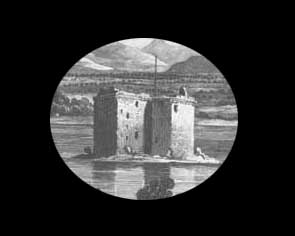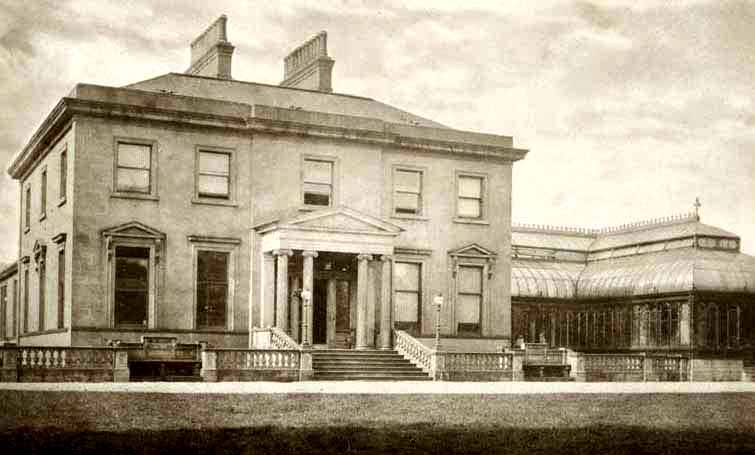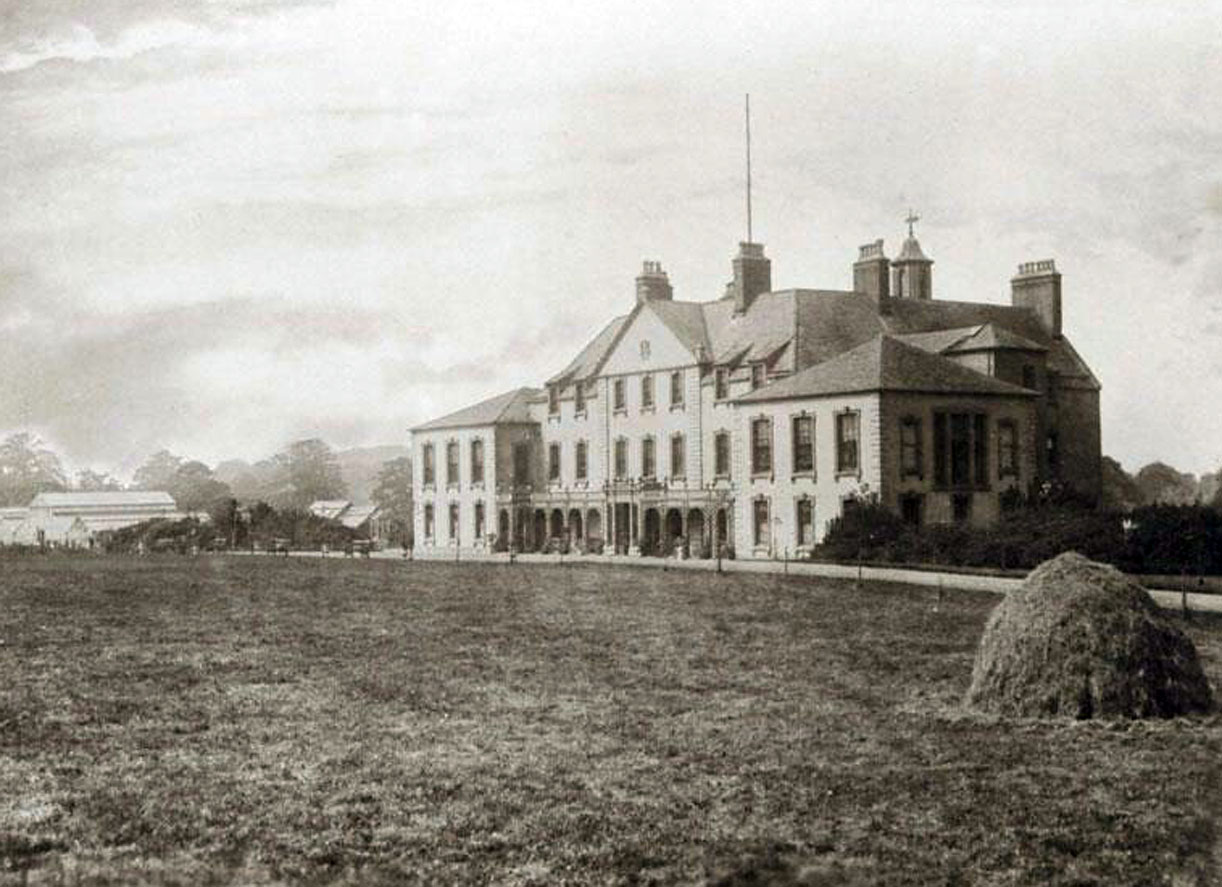
Photograph by
Thomas Annan
Hawkhead was a large mansion house situated a few
yards from what is now Ben Lawers Drive in the
modern housing estate of the same name to the
south east of Paisley.
Hawkhead (Halkhead)
estate was originally owned by the Royal Stewarts
and acquired in 1367 from the
future King Robert lI, then Earl of Strathern
by Sir John Ross for an annual payment of a
pair of gloves, or two pennies of silver, to the
King. The original name of the family was
the 'de Ros ' (from Normandy) which was changed to the Scottish 'Ross' in
1489 when Sir John Ros was inserted among
the Barons of Parliament as Lord Ross
of Hawkhead .
This was the
famous John 'Palm My Arm'
Ross who lies at Renfrew Parish Church
with his wife Marjory Mure.
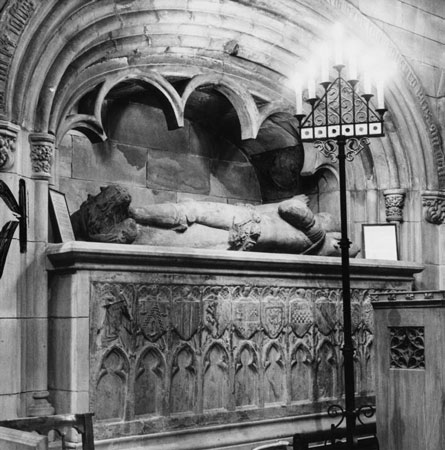 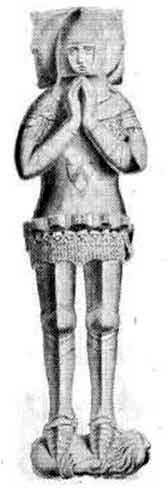
The name 'Palm My Arm'
comes from wrestling. Ross was said to have been
granted the King of Scotland's favourite
land after winning a fight to the death against a
giant Englishman with a moat on one side and a
raging fire on the other. Even though the honour
of Scotland had been saved, the King was
reluctant to let the land go, but Ross insisted.
It was King's Inch in Renfrew !! There must
be some truth to the tale because the Ross family
was granted King's Inch and owned it until
1760. The full story is here.
The family held the
estate unbroken until the 13th Lord Ross who had
no sons. He did have a daughter, who married the
third Earl of Glasgow. Their son succeeded to the
Earldom of Glasgow and was raised to the
peerage as Lord Ross of Hawkhead, that line
having died out in the male line. The estate
therefore went to the Earls of Glasgow.
Hawkhead had a very old tower, but the main part
of the building was built in 1634 including
orchards and large gardens with alterations
in 1750 to 1780 by Robert Adam, the famous
Scottish architect. It was visited in 1681 by the
Duke of York, afterwards King James VII.
The title 'Lord Ross expired with
the fourteenth Lord in 1754. and the estate passed first to his
eldest sister, Mrs Ross Mackye, and next to a
younger sister, Elizabeth, widow of the third
Earl of Glasgow. Her son, the fourth Earl,
succeeded her in 1791, and in 1815 was created Baron Ross of Hawkhead in the peerage of the United
Kingdom. The Earls of Glasgow are the Boyle family who's seat is (still) at Kelburne Castle near Largs.
The 1881
census showed a gamekeeper called James Dunlop
with his wife, mother and son, a head servant
called Margaret Wilson and another servant by the
name of Catherine Methven living in the house. In
1886 the estate was sold to William Stevenson, a
Glasgow Quarrymaster including the mansion house
and three farms to the south. Lime was quarried
on the estate and there is a disused quarry still
marked on the current Ordnance Survey map. Later
occupants included John Lye, who owned a drapery
warehouse in Glasgow
In 1914 it
became part of a mental hospital called Hawkhead
Asylum (now Leverndale Hospital). The house
itself was eventually demolished in 1953. There
were two entrances to the estate, one near the
Hurlet at the curve of the road and is still
clearly a track and the other near the river Cart
on the current cycle track at the bottom of the
hill going up to the former hospital and tower. A
road also ran from the hospital farm to the
house.There is a 1923 map below with a reservoir
(formerly a quarry) showing and the various
tracks. A water pipe ran the two miles from there to
the Saucel whisky distillery at Lonend.
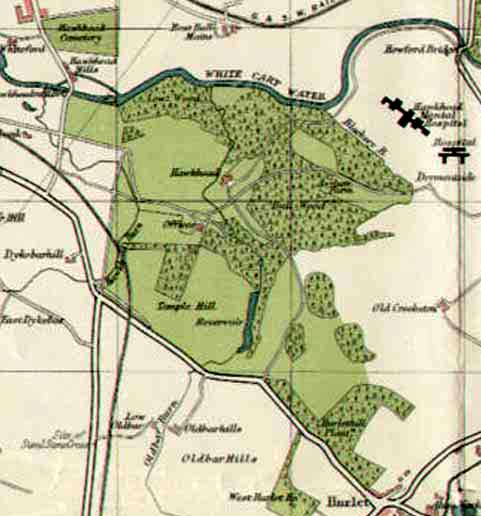
The nearby
farm, a 'B' listed building (called Hawkhead
House farm) was built in 1769 and was the
residence of the head coachman. Horses were also
kept for hunting. On the map, it is marked as
'offices'.
Below are
three recent pictures. Firstly the remains of
what are probably the cellars at the back of the
house just a few yards from the Hawkhead estate.
Secondly, the strange sight of metal traffic
barriers in the trees just a hundred or so yards
from the cycle track, which must have been a road
up to the hospital farm (now demolished). There
was also a patient's golf course near there until
a few years ago.Third is the view from the house
to Hawkhead estate.
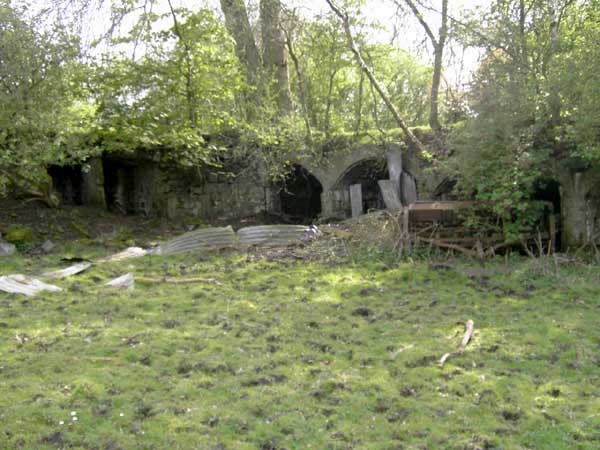 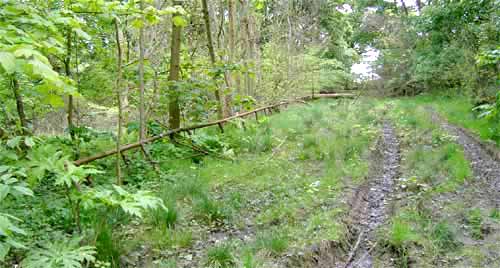 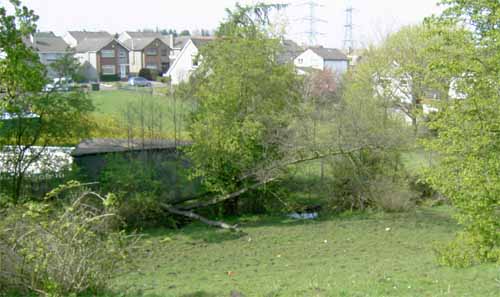
The Ross
family also gave their name to Ross maternity
hospital which was in
Hawkhead Road and became Ross House, the health
board headquarters and the Ross Hall estate
including Ross Hall private hospital on Crookston
Road and the adjacent Ross Hall Park which
was originally part of the larger Hawkhead Estate. Ross Hall Mains Farm is the
farm with the horses on Scott's Road across the
river from the cycle track.
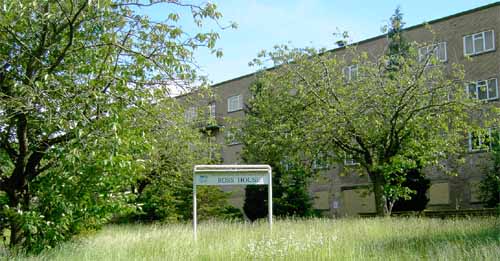 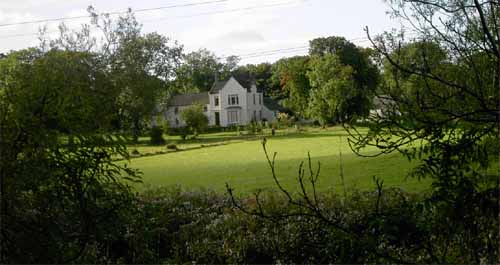 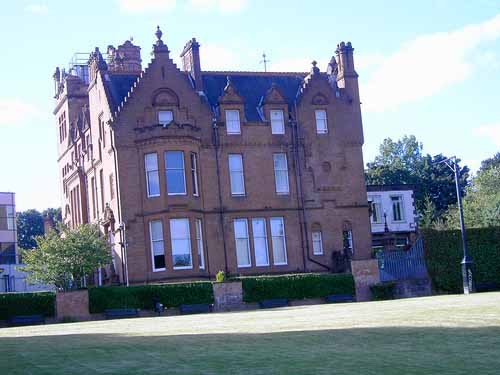
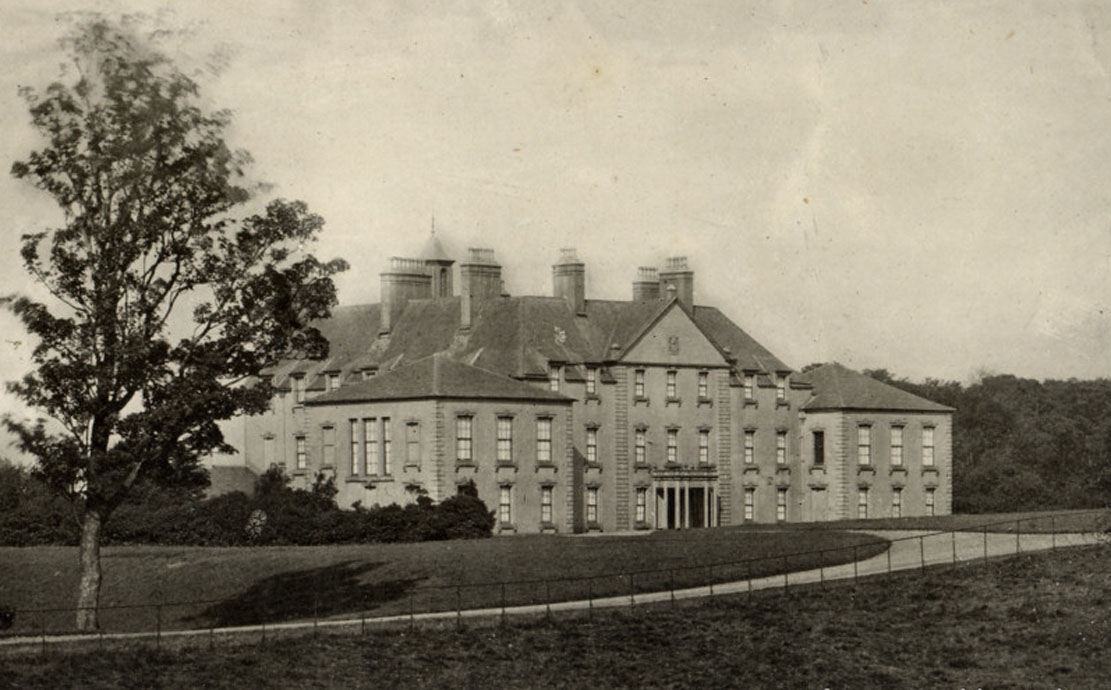
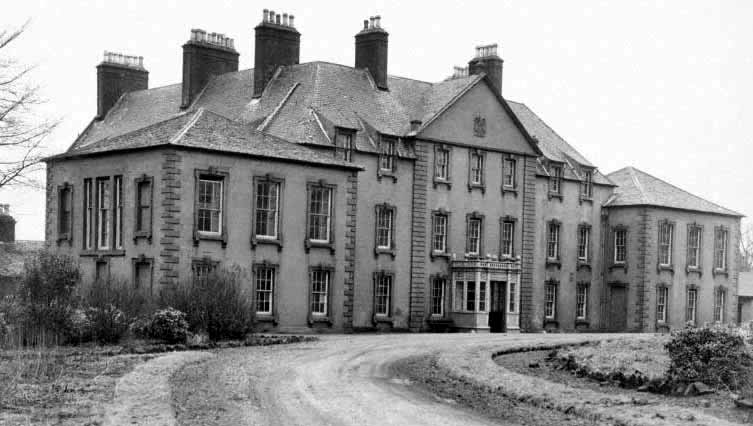
Detailed
Histories
Millar A H
(1889) The castles and mansions of Renfrewshire
and Buteshire
Hawkhead, which was until lately one of the seats
of the Earl of Glasgow, is situated about two
miles south-east of Paisley, in the Abbey parish.
The principal messuage of the estate of Hawkhead
stood formerly on the site of the present
building; and some remains of it seem to have
been in existence when Crawford wrote his history
in 1710. Referring to Hawkhead at this time, he
wrote thus:
"This fabric is
built in the form of a court, and consists of a
large old tower, to which there were lower
buildings added, in the reign of King Charles I.,
anno 1634, by James, Lord Ross, and Dame Margaret
Scott, his lady, and adorned with large orchards,
fine gardens, and pretty terraces, with regular
and stately avenues fronting the said castle, and
almost surrounded with woods and enclosures,
which adds much to the pleasure of this
seat."
After the death of
William, thirteenth and last Lord Ross, in 1754,
the estate of Hawkhead fell first to his eldest
sister, the Hon. Jane Ross ; and after her
decease, in 1777, to the younger sister, the
Right Hon. Elizabeth Ross, Countess Dowager of
Glasgow. Great alterations were made upon the
mansion by Lady Glasgow after her accession ; and
Semple, writing in 1782, speaks of her Ladyship
as "making great improvements in repairing
the manour within, which is a very ancient and
elegant structure, adorned with a large cupola on
the top. Her Ladyship is also making a new
garden, a few score yards south from the house,
consisting of near four acres of ground, with a
large green hot-house about 120 feet long. At the
back of the said green hot-house is an ice-house
building, the only one I know of in the shire.
Adjacent to the south side of the manour are a
number of different kinds of drooping trees
interspersed,-which, I imagine, has been the
pleasure-ground formerly,-where two very broad
arched stone bridges crosses over a road which
leads into the lower story of the house, which
forms a kind of square court, secured with a
baluster and rail along the breasts."
The estate of Hawkhead was originally a portion
of the lands possessed by the Royal Stewarts in
Renfrewshire. According to Mr. Riddell, the
genealogist, Sir John Ross, son of Godfrey Ross
of Tarbart, acquired the lands of Hawkhead, in
1367, from Robert lI., then Earl of Strathern,
and fixed his residence at that place. The oldest
charter, however, now in existence amongst the
documents preserved at Hawkhead, is dated 30th
March, 1390, and by it the lands of Auchinback
and Hawkhead are conferred upon Sir John Ross,
for an annual payment of a pair of gloves, or two
pennies of silver, to the King. The descent of
the family of the Rosses of Hawkhead is somewhat
obscure until the close of the fifteenth century,
at which time Sir John Ross was created Lord Ross
of Hawkhead, circa 1490. That he resided at
Hawkhead is proved by a charter dated 31st May,
I499, by which he grants to his son and
heirapparent, Sir John Ross of Malevyn, certain
lands in Linlithgow.
This document was signed by Lord Ross:-Apud
manerium de Halkhede. This son succeeded his
father as second Lord Ross, and fell at the
battle of Flodden. From him descended, in
unbroken succession, James, sixth Lord Ross, who,
with his wife Margaret, daughter of Walter, Lord
Scott of Buccleuch, made those alterations upon
the house of Hawkhead to which Crawford alludes.
Three of their sons were successively seventh,
eighth, and ninth Lords Ross ; and after the
death of the last of them, unmarried, in 1648,
the title and estates devolved upon their
kinsman, Sir William Ross of Muiriston. The
grandson of the latter was a very eminent man in
his time. He was born in 1656, and succeeded his
father as twelfth Lord Ross, in 1682. At the
Revolution of 1688 he zealously supported the
Orange party, and was a Privy Councillor both to
King. William and to Queen Anne.
He strongly advocated the Union of the
Parliaments, and was chosen one of the
Representative Peers in 1715, and appointed
Lieutenant of Renfrewshire at the same time. He
resided principally at Hawkhead, taking an active
interest in county affairs, even when advanced in
years; and he died at Hawkhead on 15th March,
1738, in the eighty-second year of his age. His
son George, thirteenth Lord Ross, was the father
of Elizabeth, Countess of Glasgow, who made the
latest alterations upon Hawkhead. She was born in
1725, married, in 1755, to John, third Earl of
Glasgow, and succeeded to the estate of Hawkhead
in the manner described.
She died at London, on 9th October, 1791. Her son
George, fourth Earl of Glasgow (nat. 1766, ob.
1843), was Lord-Lieutenant of Renfrewshire in
1810, and was raised to the Peerage of Great
Britain in 1815, with. the title of Baron Ross of
Hawkhead. His son James, fifth Earl of Glasgow,
who was also Lord-Lieutenant of Renfrewshire,
held the estate till his death in 1869, when he
was succeeded by his brother, George Frederick,
the present Earl. In 1886 the estate was exposed
to sale in lots, when Mr. William Stevenson,
Quarrymaster in Glasgow, purchased the mansion
house lot with the three farms lying to the
south, and marching with his estate of
Househill.The mansion house is presently occupied
by Mr. John Lye, Glasgow.
Ramsay Philip
(1839) Views in Renfrewshire, with historical and
descriptive notices,
SOUTH-WEST from Crookston, and amidst scenery
similar to that which has already been repeatedly
described, stands Hawkhead House, the property of
George, fourth Earl of Glasgow, a lineal
descendant, maternally, of the Rosses,' its
ancient possessors, who were sprung from the
English Rosses, -lords of the baronies of Wark
and Belvoir. A branch of that family settled in
Ayrshire, soon after the middle of the twelfth
century, and held the estate of Tarbart and other
lands in the district of Cunningham. These Rosses
were .quite unconnected with the once powerful,
but long since attainted, house of the Earls of
Ross in the North of Scotland, with whom they
have sometimes been confounded.
In the year 1367, Sir
John Ross, a younger son of Sir Godfrey Ross of
Tarbart, Sheriff of Ayr, acquired from Robert,
Earl of Strathern, afterwards King Robert IL, the
barony of Halkhead, or Hawkhead, in Renfrewshire.
He there fixed his residence, and is found
frequently witnessing deeds connected with the
West of Scotland. Other lands in Renfrewshire
were acquired by his descendants. In 1450, the
Rosses of Tarbart alienated their estate to their
cousins, the Rosses of Hawkhead, upon whom, on
the failure of the Tarbart branch, the
representation of the family afterwards devolved.
On the circle of an
arch, in the church of Renfrew, there is a Latin
inscription, which tells that Sir John Ross of
Hawkhead and Marjory, (Mure,) his lady, repose
underneath. Figures of these persons, cut in
stone, lay long below the arch : some years ago,
they were removed into an adjacent aisle, which
forms the burying place of the family, where they
may still be seen. This monument is without a
date, but, as the last Sir John Ross, who
remained a commoner, died before the year 1501,
it cannot be referred to a later period than the
end of the fifteenth century. There is a
traditionary story, that the Sir John Ross
commemorated on the monument vanquished an
English knight in single combat, from which lie
acquired the epithet of " Palm-my-arm;"
and by that name his effigy is to this day called
by the worthy burghers of Renfrew.*
Sir John Ross of
Hawkhead, a descendant of the famous "
Palmmy-arm," was, about the year 1503,
raised to the Peerage, with the title of Lord
Ross. On 7th January 1504, he was summoned, under
that title, " at his duelling-place of the
Halkhed," to appear before the Privy
Council, to answer to a complaint at the instance
of the abbot and convent of Paisley. Through his
mother, Agnes Melville, daughter and sole heiress
of Thomas Melville of that Ilk, he succeeded to
the barony of Melville in Mid-Lothian. The arms
and the style borne by his son and
successor-" Ninianus Dominus Ross ac
Melvil"-are sculptured upon a fragment of
the old Castle of Melville, now at Hawkhead. On
another stone in front of the house appear the
arms of George, tenth Lord Ross, who flourished
in the seventeenth century. The crest of this
family, a hawk's head, erased, is obviously
allusive to the name of the estate.Referring to
an authentic Memoir respecting the distinguished
family
* For. the preservation, in print, of the
tradition above referred to, we are indebted to
the late Mr Motherwell, by whom it was related in
his own peculiarly appropriate style, in the
Appendix to Hamilton of VVishaw's Work, p. 300.
The Minister of Renfrew has since given it, in a
condensed form,
in the New Statistical Account,-article "
Renfrewshire," p. 13. Neither of these
writers has noticed the combat which Sir John
Ross of Hawkhead and other two Scottish knights
fought with three foreign champions, in presence
of King James II. and his court, at Stirling, in
the year 1449, and of which there is reason to
suspect that the tradition in question is but
another version, disguised and cor-rupted in its
oral transmission from age to age.
t Chartulary of Paisley, p. 63.
of Ross, inserted in the Appendix to Robertson's
Continuation of Crawfurd's History, we pass at
once to William, thirteenth Lord Ross, who died,
unmarried, in the year 1754, after having enjoyed
the title for only two months. The title became
extinct, and the estates of Hawkhead and.
Melville devolved on his eldest sister, Jane
Ross, wife of John Ross Mackye of Palgowan. By
this lady, the estate of Melville was sold, in
the year 1760, to Captain Rennie, maternal
grandfather of the present Viscount Melville. On
her death, in 1777, her only surviving sister,
Elizabeth Ross, widow of John Boyle, third Earl
of Glasgow, succeeded to the estate of Hawkhead.
Her Ladyship having died in 1791, the estate and
representation of the noble family of Ross
devolved upon her son, George, fourth Earl of
Glasgow, whose paternal ancestors, the Boyles of
Kelburn, belong to Ayrshire, where, as free
barons, they have flourished for nearly six
centuries. The title of Baron Ross of Hawkhead, a
peer of the United Kingdom, was revived in favour
of the Earl of Glasgow, in the year 1815. The
Earl was for some years Lord Lieutenant of the
county of Renfrew. He now holds the same office
in Ayrshire. This venerable nobleman, whose
literary accomplishments are well known, is
President of the Maitland Club, for which there
was printed, at his expense, the Chartulary of
Paisley,-a valuable donation, the benefits
derived from which, in the preparation of these
Notices, are very apparent.
Hawkhead House is an irregular pile, of which
Crawfurd thus writes : -1~ This fabric is built
in the form of a court, and consists of a large
old tower, to which there were lower buildings
added in the reign of King Charles I. in 1634, by
James Lord Ross, and Dame Margaret Scott, his
lady, and adorned with large orchards, fine
gardens, and pretty terraces, with regular and
stately avenues, fronting the said Castle, and
almost surrounded with woods and inclosures,
which adds much to the pleasure of this
seat." This was one of the earliest attempts
which were made in Renfrewshire to introduce the
Dutch style of gardening, and to construct low
buildings approaching to the modern fashion, in`
addition to the high castellated places of
defence which anciently formed the habitations of
the nobility and gentry.
Very little alteration was made upon the place
from Crawfurd's time till the year 1782, when the
Countess Dowager of Glasgow greatly repaired and
improved the house, and formed a new garden,
consisting of nearly four, acres, a short
distance to the south. The estate is still finely
adorned with trees. A reverend writer has
recorded, as one of the memorable events which
happened in his time, that, in the month of
October 1681, when Scotland was under the
administration of the Duke of York, afterwards
King James IL, his Royal Highness "° dined
at the Halcat with my Lord Ross," This
nobleman, George, tenth Lord Ross, was a zealous
adherent to the Stewart family ; hence the mark
of distinction which the lofty Viceroy paid to
him. His son and successor, William, was a
promoter of the Revolution of 1688, and, after
that event, held several high offices in the
State.
* Law's Memorialls, p. 205.
|
